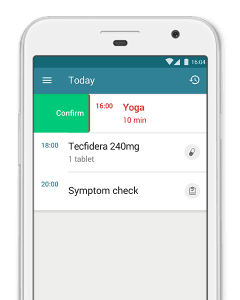Multiple sclerosis (MS) is a chronic autoimmune disease that affects the functions of the brain and spinal cord central nervous system (CNS). In MS, the immune system attacks the myelin (protective sheath that covers nerve fibers) and causes communication problems between the brain and the rest of the body. The symptoms of MS are unique to everyone. It depends on the level of severity and which nerves are damaged by the disease. Some people may have mild symptoms and don’t need treatment, whereas for some, the symptoms can cause balance, vision, and muscle control problems, including MS hug. If you have MS and you’ve never heard about MS hug, you might not be the only one. This symptom is rarely discussed, despite its frequent occurrence among MS patients. MS hug is also underrated, even though it can prevent people from doing regular activities independently by causing tightness in the chest and breathing problems. Find out more about MS hug, including what you can do to prevent and manage MS hug when it strikes.
What is an MS hug and how does the pain feel like?
MS hug is a symptom of MS which makes you feel as if you have a band around your ribs that wraps and presses your chest tightly. The pressure will make you feel uncomfortable (like being squeezed), and in some cases, can even cause breathing difficulty. Many people describe this condition as if they’re being “hugged” too forcefully, and thus the name ‘MS hug’.
Unfortunately, tightness in the chest and difficulty in breathing are two symptoms that aren’t specific to MS. This makes MS hug easily mistaken for other conditions, such as heart or breathing disorders. However, if you’ve already been diagnosed with MS and experience chest pain, you’re likely to have an MS hug.
Besides occurring in the torso area, symptoms of MS hug can also occur in the hands and feet. The feeling is similar to the one in the chest. Instead of being pressed by a tight band, you may feel as if you’re wearing tight gloves or shoes that make you feel as though you’re being crushed or tickled. In other cases, MS hug may also happen in other parts of the body, such as arms, legs, and head.
What causes MS hug?
Since MS impairs the nerves in the spinal cord, the damaged nerves can send wrong messages to the brain, and eventually, the brain relays incorrect signals to the rest of the body. There may be a discrepancy in what your body feels and what really happens to your body. For example, in an MS hug, there is nothing that wraps around your torso that can cause tightness and pain, but you feel like something “hugs” your chest tightly. In other words, there is no real damage to the area where you feel hurt. Rather, the damage is in the nerves that communicate to the brain what’s happening in another part of the body. The medical name for this sensation is called dysesthesia, which means ‘abnormal sensation.’
MS hug can also happen when the intercostal muscles (various groups of muscles that run between the ribs and move the chest wall when breathing) experience spasms. This makes the muscles in your torso lose their flexibility and hurt if they’re moved.
Either way, any chest pain shouldn’t be taken lightly. Talk to your doctor to get a proper diagnosis of your condition.
How long does MS hug last?
Each patient experiences a different sensation over a different time period. MS hug can last anywhere between seconds to months as a constant sensation. Because of this, the pain and discomfort caused by MS hug can affect daily activities, especially for those who experience severe symptoms.
What can I do if I have MS hug?
If you think you have an MS hug, confer with your doctor. It may be the sign of an MS relapse, especially if other MS symptoms occur at the same time as the MS hug, such as vision, bladder, and bowel problems, among many others. It’s important to check your condition if you notice any of the MS hug symptoms.
As mentioned before, the symptoms of MS hug can resemble heart or breathing disorder. To rule this possibility out, you may be asked to take an MRI test so that an accurate diagnosis of the cause of the pressure can be discovered. Contact your doctor as soon as possible for prompt and proper treatment.
Can I prevent MS hug?
Yes, you can try to prevent MS hug. Oftentimes, triggers for an MS hug are likely to be the same as triggers for other MS symptoms. Some of the triggers can include fighting a cold/flu, bladder infection, fatigue, stress, or hot flashes. Learn and remember what triggers your MS hug symptom to avoid having it again in the future.
Can I manage MS hug on my own?
Generally, MS hugs can pass without treatment. However, for those who feel too uncomfortable with the pain or if the MS hug is persistent, there are some things that can help you to ease the pain.
1. Drug therapy
The type of medication will be based on the cause of your MS hug.
If it is caused by nerve/neuropathic pain or dysesthesia, you may be prescribed anticonvulsants medicine such as gabapentin (Neurontin), antidepressants such as amitriptyline (Elavil), or over-the-counter pain relievers that contain acetaminophen such as Tylenol.
If the MS hug is caused by muscle spasms, your doctor may give you baclofen (Gablofen) to reduce transmission of messages between nerves, or tizanidine (Zanaflex) to block the impulse that causes muscles to tighten.
If the symptoms are part of a relapse, you might have to take steroids as well.
A drug combination might also be an option in treating MS hug. You should talk with your doctor and check your progress regularly so that you can switch to other alternative drugs if something isn’t working well.
2. Lifestyle adjustment
Besides drug therapy, there are some lifestyle adjustments and home remedies that can make you feel more comfortable when an MS hug strikes.
The idea is to trick and teach your brain to associate the tightness in the chest as an effect of wearing tight clothes instead of an MS hug effect. If you’re wearing tight clothes or having a scarf/bandage around the chest during or right after an episode starts, it may help your nerve system to translate the feelings of pain into being “hugged” by snuggly clothes, and signal pain-free pressure instead of being forcefully squeezed. You can also do this by applying pressure to the area with the flat of your hand.
Some people find that wearing loose clothes could lessen the feeling of being crushed during an MS hug episode. You may have to try both options to find out what works for you.
Other home remedies that you can try are applying a warm compress (remember that heat might not work for everyone), have enough rest (sleep), and use deep breathing techniques (through yoga and meditation).
MS is a long-term, non-curable disease. However, treatment can help to manage the symptoms, prevent a relapse, and prolong the periods of remission (periods where there are only a few or no symptoms occur). Each case of MS is different, and each MS hug story is unique. Discuss with your doctor your condition and the MS hug symptoms you experience so that you can receive the best treatment that fits with your diagnosis.
Here are some articles that we think you might be interested in:
Emerging Therapies for Multiple Sclerosis: What’s in the MS Drug Pipeline?



